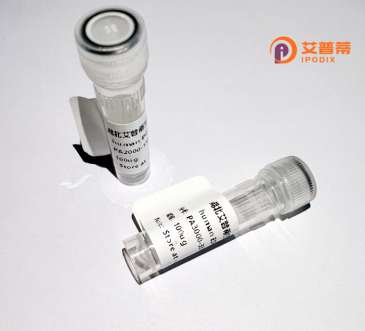
| 纯度 | >90%SDS-PAGE. |
| 种属 | Human |
| 靶点 | ATRIP |
| Uniprot No | Q8WXE1 |
| 内毒素 | < 0.01EU/μg |
| 表达宿主 | E.coli |
| 表达区间 | 1-671aa |
| 氨基酸序列 | MSKNPSGKNRETVPIKDNFELEVLQAQYKELKEKMKVMEEEVLIKNGEIKILRDSLHQTESVLEEQRRSHFLLEQEKTQALSDKEKEFSKKLQSLQSELQFKDAEMNELRTKLQTSERANKLAAPSVSHVSPRKNPSVVIKPEACSPQFGKTSFPTKESFSANMSLPHPCQTESGYKPLVGREDSKLHSLRGDSIKQEEAQKSFVDSWRQRSNTQGSILINLLLKQPLIPGSSLSLCHLLSSSSESPAGTPLQPPGFGSTLAGMSGLRTTGSYDGSFSLSALREAQNLAFTGLNLVARNECSRDGDPAEGGRRAFPLCQLPGAVHFLPLVQFFIGLHCQALQDLAAAKRSGAPGDSPTHSSCVSSGVETNPEDSVCILEGFSVTALSILQHLVCHSGAVVSLLLSGVGADSAAGEGNRSLVHRLSDGDMTSALRGVADDQGQHPLLKMLLHLLAFSSAATGHLQASVLTQCLKVLVKLAENTSCDFLPRFQCVFQVLPKCLSPETPLPSVLLAVELLSLLADHDQLAPQLCSHSEGCLLLLLYMYITSRPDRVALETQWLQLEQEVVRALTVMLHRQWLTVRRAGGPPRTDQQRRTVRCLRDTVLLLHGLSQKDKLFMMHCVEVLHQFDQVMPGVSMLIRGLPDVTDCEEAALDDLCAAETDVEDPEVECG |
| 分子量 | 100.21 kDa |
| 蛋白标签 | GST-tag at N-terminal |
| 缓冲液 | 冻干粉 |
| 稳定性 & 储存条件 | Lyophilized protein should be stored at ≤ -20°C, stable for one year after receipt. Reconstituted protein solution can be stored at 2-8°C for 2-7 days. Aliquots of reconstituted samples are stable at ≤ -20°C for 3 months. |
| 复溶 | Always centrifuge tubes before opening.Do not mix by vortex or pipetting. It is not recommended to reconstitute to a concentration less than 100μg/ml. Dissolve the lyophilized protein in distilled water. Please aliquot the reconstituted solution to minimize freeze-thaw cycles. |
以下是关于重组人ATR相互作用蛋白(ATRIP)的3篇代表性参考文献及其摘要概括:
---
1. **文献名称**: *"ATRIP: a novel component of the ATR-checkpoint pathway"*
**作者**: Cortez D, Guntuku S, Qin J, et al.
**摘要**: 该研究首次发现ATRIP是ATR激酶的关键结合蛋白,揭示了ATRIP在DNA损伤信号传导中的作用,证明其通过与单链DNA结合复合物RPA相互作用,协助ATR招募至DNA损伤位点以激活细胞周期检查点。
---
2. **文献名称**: *"Constitutive phosphorylation of ATRIP by DNA-dependent protein kinase regulates ATR checkpoint activation"*
**作者**: Ball HL, Myers JS, Cortez D.
**摘要**: 本文阐明了DNA依赖的蛋白激酶(DNA-PK)通过磷酸化ATRIP的特定氨基酸残基(如Ser-224),调控ATR-ATRIP复合物的稳定性及其在DNA损伤修复中的功能,揭示了ATRIP翻译后修饰对检查点激活的重要性。
---
3. **文献名称**: *"TopBP1 activates the ATR-ATRIP complex to regulate DNA replication stress responses"*
**作者**: Mordes DA, Glick GG, Zhao R, et al.
**摘要**: 研究证明了ATRIP与TopBP1的相互作用在复制应激响应中的关键作用,TopBP1通过激活ATR-ATRIP复合物促进下游信号级联(如CHK1磷酸化),维持基因组稳定性。
---
这些研究涵盖了ATRIP与ATR的相互作用机制、磷酸化调控及其在DNA损伤应答中的核心功能。如需扩展阅读,建议通过PubMed或Web of Science检索关键词“ATRIP”和“DNA damage response”。
ATR-interacting protein (ATRIP) is a critical component of the ATR-mediated DNA damage response (DDR) pathway, essential for maintaining genomic stability. It acts as a direct binding partner of the Ataxia Telangiectasia and Rad3-related (ATR) kinase, forming a stable complex that senses replication stress and DNA lesions. ATRIP recruits ATR to single-stranded DNA (ssDNA) regions generated during replication fork stalling or damage processing, facilitated by its interaction with replication protein A (RPA)-coated ssDNA. This localization enables ATR activation, initiating checkpoint signaling to halt the cell cycle, stabilize stalled forks, and promote DNA repair.
Structurally, human ATRIP contains an N-terminal ATR-binding domain and a C-terminal coiled-coil domain critical for homodimerization and interaction with TopBP1. a co-activator of ATR. Post-translational modifications, including phosphorylation, regulate its function in DDR. Studies using recombinant human ATRIP, often produced via heterologous expression systems, have elucidated its role in facilitating ATR’s substrate recognition and coordinating with downstream effectors like CHK1. Dysregulation of ATR-ATRIP signaling is linked to diseases such as cancer and neurodegeneration, making it a potential therapeutic target. Recombinant ATRIP tools enable mechanistic studies of DDR and screening for inhibitors to exploit synthetic lethality in cancer therapy.
×